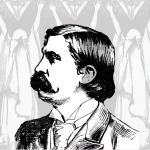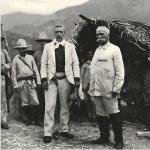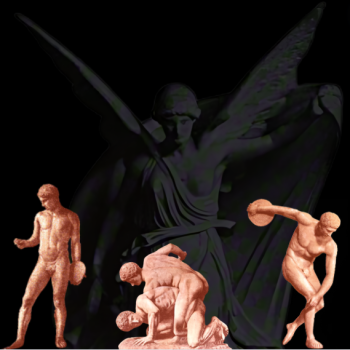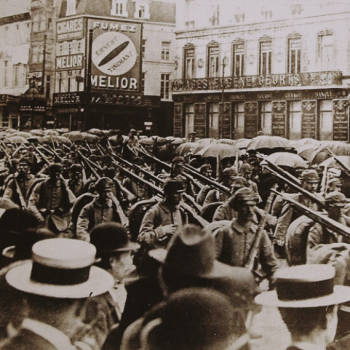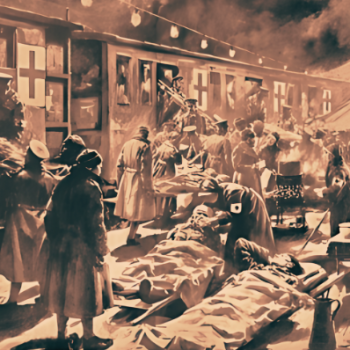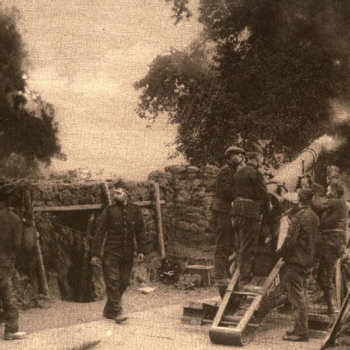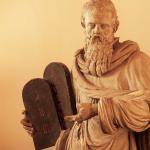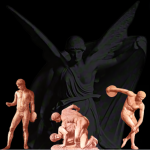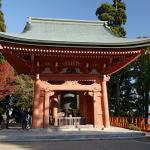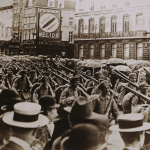I had wanted to write about the Theosophical Society in the American South, and when thinking about what title I might choose, I remembered how strange the word “Dixie” was. For many years I had assumed the word was a reference to the Mason-Dixon Line, and those States below it. I was wrong. We find the real origin of the word in antebellum Louisiana, the Francophone colony which the United States purchased from the French in 1803. For a number of years preceding the Civil War, the $10-note of the Citizens’ Bank in Louisiana, the “dix” (French for “ten,”) was widely circulated in the South via the steamboatmen on the Mississippi River. An almost universal expression used by these steamboatmen, when leaving from the “up-river” country for New Orleans, in answer to questions about their destination, was: “We’re going South after dixes,” or going to “Dixie-land.”[1]
I then thought of a clip I recently watched titled “The Unexpected Origins Of The Word ‘Monster,’” in a segment called “Otherwords” in the PBS program “Storied.” In the segment, socio-linguist, Dr. Erica Brozovsky, gave a breakdown of the etymology of the word “monster.” Here is my less elegant summary Brovovsky’s history of that word. “Monster” entered the English language from the French “monstre,” after William the Conqueror invaded England and installed French nobility to rule the land. French, therefore, came to be seen as the language of the aristocracy. France, having been conquered centuries before by Julius Caesar, had developed her language from its own native Gallic and the imported vernacular (vulgar) Latin. That was how English, a Germanic language, became infused with Latin words. As for the word “monster,” it came from the Latin word “monstrum” meaning “bad omen.” This appellation was given to those parts of the natural world that showed signs of abnormality. “Monstrum” itself stemmed from the word “monere” meaning “to warn.” Some believed that the goddess Juno Moneta was a cognate with “monere,” for, as the deity of Roman funds, she warned against economic instability. It was from Juno Moneta that we got the word “money,” itself a cognate with “monster.”
When different languages come into contact with one another, they sometimes simplify and merge into a new form called a “pidgin” language. Here is where we find axioms like “Chop-Chop,” and “No can do.”[2] As far as I can tell, both those expressions arose about the same time and place as the word “pidgin” itself, that is to say, they developed in California in the 1890s when the Chinese immigrant community engaged with English-speakers. One California newspaper tried to explain the phenomenon: “To strangers the ‘p’dgin’ English is very confusing […] If the [Chinese] are busy, they will tell you they ‘hap pidgin,’—pidgin being the nearest they can come to pronouncing the word ‘business.’”[3] A “pidgin” language will then sometimes expand into stabilized natural languages called “creole” languages. “Creole” being the French word for the Portuguese “crioulo,” meaning “Black person born in Brazil,” stemming from “criar” (from Latin “creare” meaning “to breed/produce/create.”)
Another word that is useful term in the discussion of Theosophy in “Dixie” is the word “fetish.” As historian William Pietz notes, the word began its life as the Latin adjective “facticius,” meaning “manufactured.” This became the Portuguese word “feitiço,” which, in the late Middle Ages, meant “witchcraft.” During the Trans-Atlantic slave trade in the sixteenth and seventeenth centuries, the word became the pidgin “fetisso” in the cross-cultural spaces of West Africa. In Pietz’s essay, “The Problem Of The Fetish,” he addresses the concerns of ethnographers who championed the Akan-speaking African word suman over the term “fetish,” as the latter was seen as a “corrupt genus that obscures the true meaning of the socioreligious practices and artifacts of various non-Western societies.” For Pietz, such attempts at translating terms like “fetish” back into native terminology ignores the historical cross-cultural story. Whatever ingredients that went into the “gumbo” of the term, it was now a “novel word responsive to an unprecedented type of situation.”[4] If the early Theosophists were participating in a project of “pidgin” religion, then the constellation of praxes in subsequent generations of Theosophists, like yoga or meditation, might well be considered “creole.” Like “the problem of the fetish,” translating such spiritual practices back into their “native languages” ignores the historical space in which they developed in the first place.
Perhaps here is the most suitable place to mention the short-lived Haitian Theosophical Society, which, thematically and chronologically, weaves into our topic. There was a connection between the Theosophical Society and Haiti which went back to the early years in New York. Alfred Harrisse, a member of the Haitian diplomatic service, who, being an amateur artist, traveled in the circles of bohemian artists who frequented Blavatsky’s parlors.[5] Strictly speaking, however, a charter for the Haitian Branch of the Theosophical Society was not issued until to 1886, when James Theodore Holly (1829-1911) wanted to start a Branch in Port-au-Prince.[6] It is unclear when Holly joined, but it may have been in 1881, around the time that Dr. Charles E. Taylor became the Society’s representative of the Danish West Indies Branch.[7] Holly, the first African-American Episcopalian bishop, was certainly no stranger to avant-garde dispensationalism. In 1884 he published a paper in which he divided history into three dispensations. The first was the Mosaic dispensation, when the “Semitic race” (Jews) first received God’s revelation. The second was Gospel dispensation, when the “Japhetic race” (Whites) spread the word of God. The third dispensation was the Millennial, when during which the “Hamitic race,” (Blacks,) would realize the Gospel’s promise by virtue of their suffering.[8] A revolution broke out in Haiti a year after the charter was issued, and a power struggle between General Legitime and Louis Hippolyte commenced.[9] In 1888, Holly wrote to encouragingly to Col. Henry S. Olcott (President of the Theosophical Society) about the speedy formation of a Branch in Haiti that was to be “composed entirely of educated negro gentlemen.”[10] It did not last long. The revolution finished off the group in 1890.[11] The “residue” of Theosophical thought, however, remained. Holly’s own son, Arthur Holly, would, years later, write a book about Haitian religion in which he stated that Haitian mediums did not channel the souls of the dead, but rather “astral bodies.”[12]
The first Branch of the Theosophical Society in the South began when Carl F. Redwitz, the former President of the Krishna T.S. (Philadelphia) moved to New Orleans.[13] In the summer of 1890, Redwitz sent an application to Charter a new Branch to be known as the Vyasa T.S. Redwitz was joined by five men, all physicians, and opened its career with two commendable and auspicious acts. The first was a gift to William Quan Judge’s (General Secretary of the American Section of Theosophical Society) office expenses, and the second was the immediate establishment of a Branch Library.[14] At the time it only admitted male members, and its proceedings were conducted entirely in French.[15]
On November 15, 1890, Judge issued a Charter for the second Branch of the South, the Siddhartha T.S. of Vicksburg, Mississippi. The President was James Gibson, and the Secretary James B. Thompson.[16] A month later, on December 10, 1890, a Branch charter was issued for Memphis T.S. (Memphis, Tennessee.)[17] Dr. Max Samfield was the President, and William H. Hotchkiss was the Secretary.[18] Samfield was a forty-six year old German Rabbi who came to America in 1867 at the invitation of Congregation Bnai Zion in Shreveport, Louisiana. He was instrumental in erecting a new synagogue for the community. In 1871 he was elected Rabbi of Congregation Bnai Israel of Memphis. Here, in 1884, he was also privileged to dedicate a new house of worship. In 1885 he established The Jewish Spectator, only one of two Jewish publications in the South.[19] Although small in numbers, the Jews of Memphis were highly visible, and played an important role in the history of the city. Samfield and his congregation were community activists who were honored by fellow Memphians for their “eleemosynary, cultural, and literary contributions.”[20] (Only two more Branches would be established in the South in the coming years, Macon, Georgia in 1893, and Nashville, Tennessee in 1895.)[21]
One notable member of the Vyasa T.S. was Dr. Charles Lopez, a third generation homeopathic physician, known for treating cholera patients among the immigrant populations.[22] Born in Cuba, Lopez had immigrated to America with his family in 1869, and settled in New Orleans.[23] He received the degree of A.M and B.M from the University of Havana, but upon coming to New Orleans he entered the medical college and received the degree of M.D.[24] Regarding the “Master,” Lopez would state:
If the men of our race and age are ever going to make of Theosophy a practical guide in their daily life and not a mere speculation, an intellectual fad, or a sort of system of mental gymnastics, they must first conceive the Masters as ideals to imitate, as men more advanced on the path of evolution than the best of us, nearer to perfection and freer from the many obstacles that our ignorance of the ultimate forces of nature opposes to the exercise of our will. This conception of what a Master must be devoid of superstition and mysticism.[25]
The notion of an American “melting-pot” was salvific for Lopez. “Here, on [the American] continent, is forming a new race, composed elements from all the nations of earth,” Lopez would state. “This new race is through long ages of development and progress, to carry the civilization of the world to a higher plane than that reached by any of nations of the world hitherto.”[26] This, unfortunately, was not a view shared by all. In fact, the notion of different races coming together sparked a genuine anxiety in some segments of power. Race-mixing was seen as unnatural, as Louisiana Governor Samuel McEnery declared in 1887 when the State Militia suppressed a cooperative strike of sugar workers that crossed the color lines. “God Almighty has drawn the color line.”[27] But this was not always the sentiment.
New Orleans, a culturally heterogeneous, polyglot, frontier town, was an outlier from the beginning. The first settlers claimed from swamp and river the site for their crescent-shaped city in comparatively few years. There came together a contrasting population of trappers, fishermen, flat-boatmen, pirates, West Indian immigrants, Jesuit, Capuchin, and Benedictine missionaries, Spanish courtiers, and French Canadians from Acadia known variously as “Acadiens,” “Cadiens,” and “Cajuns.”[28] The supply of wives for the early colonists being “unsatisfactory in point of character,” the King of France sent them a “cargo of virtuous maidens who are chronicled as filles de la cassette, or ‘casket girls,’” so-called for the caskets they brought with them to hold the modest trousseaux provided by the king. The devout erudite Ursuline nuns who chaperoned the “casket girls” in this strange land before marriage, remained in the city to educate their children afterwards.[29]
During the two decades after Louisiana became a part of America, a wave of Northerners migrated to New Orleans. These newcomers often intermarried with the native French and Spanish population. A second influx of Northerners coincided with the economic growth of the city in the years before 1837. Focused almost exclusively on mercantile interests, this second wave of Yankee settlers established retail and wholesale enterprises, and became sugar and cotton brokers, commission merchants, and served as agents of Northern banking, export, and merchandising houses. (The second wave of migration was temporarily halted by the depression of 1837.)[30] In the 1840s New Orleans saw an influx of European immigrants, and a third wave of Northerners (who merged with members of the previous groups to form the northern-born community New Orleans.)[31] This marked the beginning of a rapid “Americanization” of the city. The pressure from social and economic competition was felt among the native Creoles. Though White Creoles maintained their identity until the Civil War, Black Creoles fared worse. A three-tiered caste system soon emerged.[32] This was also the beginning of the active institutional handicapping of Francophone accessibility, which was viewed as the language of the poor among Anglo-Protestants. (That the Vyasa T.S. held their meetings in French may indicate a subversive element to the Branch.) The newly-arrived Anglo-Protestant Americans viewed Catholicism as idolatry, and thought the White Creoles were frivolous, uneducated, and lacking in business acumen. Other were unsettled by the degree of race-mixing, and the number and independence of the free Blacks.[33] This gave rise to a fear of “voodoo,” a term derived from the French “vaudoux.” Though some at the time believed that this stemmed from the Vaudois, a Christian sect from Pays de Vaud, France, that were accused of practicing witchcraft.[34] The word, however, actually derived from the West African languages Ewe (“vodu,”) and Fon (“vodun.”)[35] While Voodoo (and other spiritualities of African origin) were not officially sanctioned in colonial Louisiana, the French and Spanish governments were reasonably tolerant, and practitioners were rarely interfered with.[36] We find Voodoo entering the English lexicon in the nineteenth-century, and gaining traction in the decade preceding the Civil War. This was just about the time that Madame Blavatsky was in New Orleans in 1851, and one of her biographers writes:
At New Orleans the principal interest of her visit centered in the Voodoos, a sect of negroes, natives of the West Indies, and half-castes, addicted to a form of magic practices that no highly trained occult student would have anything to do with, but which nevertheless presented attractions to Mme. Blavatsky, not yet far advanced enough in the knowledge held in reserve for her to distinguish “black” from “white” varieties of mystic exercise. The Voodoos’ pretensions were of course discredited by the educated white population of New Orleans, but they were none the less shunned and feared.[37]
It was claimed that these “voodoo” ceremonies were dangerous because they brought people of different races together, encouraged abolitionist activities, and lured White women into “unsavory practices.” There was already a law forbidding the practice of Obeeyah (a blanket term used to describe African spirituality) as it was believed that it encouraged rebellion among the Black slaves. It was often vilified by conjuring images of “sorcery,” and “devil-worship.” June 24, the Feast Day of St. John the Baptist, was said to be the great holiday of “voodoo” practitioners. One paper of the time writes:
All nature in the far South has attained its grand climacteric. The poison plants are now fullest of their sap. Their life blood has grown thick, strong, and turgid under the semi-tropic heat. The things that feed upon them are swollen and fullest of their deadly quality and most powerful in malign instincts for destruction. So, far from civilized touch, where the remotest wilds of labyrinthine bayous sluggishly make their bends and coils and rear curious islands, where the hunter of the swamps but seldom wanders, where mighty alligators live without fear, in places like these, the worshippers of the Serpent meet on the night of St. John’s day and enact their savage rites and strange incantations as old as their race.[38]
During the reconstruction following the Civil War, the eroticized imagery of voodoo was actively invoked to enflame the imagination. Voodoo was a great anxiety for the religion of racial-sexual-politics, and Black bodies became their “fetish.” By the 1890s segregation was firmly in place in New Orleans, and the mainstream media gleefully mocked anything of African origin.[39] This sensationalism could even be found Theosophical literature. In the November 1890 issue of Lucifer, in an article titled, “African Magic.”[40] The article, however, was likely capitalizing on the news of the day. In early November 1890, the headlines stated that James Jameson (heir of the Jameson Whiskey distillery) had paid a slaver to witness a cannibalistic act while on the Stanley Expedition in Africa.[41] Perhaps this fear of “voodoo” was more a realization that the civility of claimed by the Whites in power was really only a charade.
In the autumn of 1891, while in San Francisco, W.Q. Judge would be mocked by the columnist Ambrose Bierce.[42] Weeks later Bierce would publish a short story in the December 1891 issue of The Wave (San Francisco) titled, “The Death Of Halpin Frayser.” The work was notable, as it was one of, if not the first, “zombie” story, a genre that would become synonymous with voodoo.[43] Going back to the word “monster,” perhaps we might find in the literature of this time an “omen” of sorts. If horror is a way to give form to fear, than what fear might a “zombie” personify? Immigration perhaps? Disease? That was certainly the case with another “monster” that would come to be associated with the Crescent City, the Vampire. It was a creature that was enjoying some popularity in popular culture, the Theosophist, Franz Hartmann, writing on the subject in 1889.[44] “Of all the forms of the real or supposed intercourse between the living and dead,” Olcott writes in 1891, “that of the vampire is the most loathsome. The horrid physical effects which follow after the burial of a corpse, have, no doubt, had much to do in creating the sentiment of disgust and terror which associates with the thought of this return of the dead to prey upon the living.”[45] Perhaps these writings influenced Bram Stoker (his sister-in-law, Lady Emily Thornley Stoker, joined the Theosophical Society in 1892.)[46] As the subtext of Dracula (1897) deals with an “other” who seduces Anglo women by means of sorcery, it’s little surprise the theme should resonate in New Orleans. One could also read it as science vs. superstition, and the fear that the former would succumb to the latter. I imagine the second interpretation would have resonated with Dr. Lopez at the time. One of his patients, Elmire Marie Charpentier, was one of the most startling cases in medical history. In 1882, when she was 18 years old, she went into a trance. From that moment on, she would become comatose for twenty-two hours a day, appearing in a “death-like” state.[47]
The second Branch in New Orleans, the Sarasvati Lodge T. S., was chartered on May 23, 1892 with five charter-member and was the 61st Branch on the American roll. Meetings were held at 142 Carondelet Street, but later removed to 150 Canal Street in the office of Dr. Lopez. It admitted both sexes and conducted its proceedings in English, “thus meeting a need in that important city.”[48] Its President was Julia K. Chandler, and her son, Robert Chandler, was Secretary. Though a New Orleans native, Chandler joined the San Francisco T.S. in October 1891, and she no doubt imported some of the utopian flavor of Californian Bellamy-Nationalists.[49] (In 1897, Bacarisse became head of the first chapter of the Socialist National Union of the Brotherhood of Cooperative Commonwealth.)[50] The Sarasvati Lodge, it was said, “was formed amid many discouragements and at first conducted through many struggles, but energy resulted in the establishment of a Headquarters in the heart of New Orleans and a gradual hold on the public.” Its eventual success was due to the “kind aid of Vyasa T.S.” An active member of the Sarasvati wanted to form a Branch in Havana, as it was a “hopeful prospect,” while another member established a Branch in Spain. Around this time, some members of the Vyasa T.S. also went to Nicaragua, and chartered the Central American T.S. in March 13, 1894.[51] (This may have affected the numbers of the Vyasa, for by 1894 women were admitted to that Branch.)[52] At the Convention of the American Theosophical Society in 1893, the report for the Sarasvati Branch stated: “Theosophists are translating documents for its benefit. We are also corresponding with and aiding a worker in the United States of Columbia, and are taking steps to give Theosophy to the colored people in our city. They can use the Headquarters whenever they form a Lodge.”[53] By 1893, more legislation was passed in New Orleans that saw greater racial segregation. The institutionalized “othering” of anyone who was not Anglo-Protestant, brought the outsiders closer together, however. The “common alienation” would produce a “creole” music known as Jazz.[54] The Theosophist, E.A. Neresheimer, when asked about the “virgin genius” of American music at this time, would state:
A deviation in rhythm, founded upon the sentiment which the negro has introduced into America. It is no doubt also true that just as most of the races of the world meet in this country, and to a certain extent tend to merge their peculiarities, the result being an original production; so with music the tendency is to assimilate the qualities of the music of the western world with possibly something of the oriental from—which is gradually evolving a new style or school.[55]
SOURCES:
[1] “Origin Of The Term ‘Dixie.’” The Rand McNally Bankers’ Monthly. Vol. XVIII, No. 1 (July 1899): 16-17.
[2] “He Was From Ventura.” The Los Angeles Herald. (Los Angeles, California.) September 11, 1894.
[3] [“Housekeeping In China.” The Record-Union. (Sacramento, California.) March 23, 1894.]
[4] Pietz, William. “The Problem Of The Fetish: Pt. I.” Anthropology And Aesthetics. No. 9 (Spring 1985): 5-17.
[5] “Theosophy.” The New York Echo. (New York, New York) April 30, 1878; Olcott writes: “M. Harrisse, our French friend, was a bit of an artist.” [Olcott, Henry Steel. Old Diary Leaves: Volume I. Theosophical Publishing Society. London, England. (1895): 203.] David A. Curtis elaborates further in another article: “[Pashkova] met Mr. Harrisse, of the Haytian diplomatic service, and was by him introduced in a small social circle of friends, among whom was an old friend, Mme. Blavatsky.” [Curtis, David A. “A Modern Sibyl.” The Los Angeles Evening Express. (Los Angeles, California) April 21, 1888. ] A “Mr. A. Harrisse, Attaché Haytian Consulate, New York,” is listed as a member of the Diplomatic Corp. in 1878-1879 at that time. The name Alfred Harrisse is also the name provided for Secretary of the Haytian Pavilion in the 1893 World’s Fair. [Official Congressional Directory. U.S. Government Printing Office. Washington, D.C. (1879): 125; Handy, Moses Purnell. World’s Columbian Exposition 1893 Official Catalogue: Part I. W. B. Conkey Company. Chicago, Illinois. (1893): 20.] Harrisse would produce the first known portrait of Master Morya. [Blavatsky, Helena P. Collected Writings Volume I (1874-1878.) Theosophical Publishing House. Wheaton, Illinois. (1966): 435.]
[6] “Branches of the Theosophical Society.” The Theosophist. Vol. X. (1889): General Report Of The Thirteenth Convention And Anniversary Of The Theosophical Society: 68-82.
[7] Theosophical Society General Membership Register, 1875-1942 at http://tsmembers.org/. See book 1, entry 726. (Website file: 1A:1875-1885) Charles E. Taylor. St. Thomas. Dutch West Indies. (3/14/1881); “The Danish West Indies.” The Theosophist. Vol. XI, No. 126 (March 1890): 343.
[8] Curtis IV, Edward E. Islam In Black America. State University Of New York Press. Albany, New York. (2002): 65-66.
[9] Fiske, Amos Kidder. The West Indies: A History Of The Islands Of The West Indian Archipelago. G. P. Putnam’s Sons. New York, New York. (1911): 245.
[10] “Theosophical Activities.” The Path. Vol. III, No. 4 (July 1888): 132-136.
[11] Olcott, Henry S. “The Outlook.” The Theosophist. Vol. XI, No. 126 (March 1890): 285-292.
[12] Derby, Lauren. “Imperial Idols: French and United States Revenants In Haitian Vodou.” History of Religions. Vol. LIV, No. 4 (May 2015): 394–422.
[13] Theosophical Society General Membership Register, 1875-1942 at http://tsmembers.org/. See book 1, entry 3567. (Website file: 1B:1885-1890) Carl F. Redwitz. (1/14/1886).
[14] “Theosophical Activities.” The Path. Vol. V, No. 4 (July 1890): 130-139.
[15] “rror Of The Movement.” The Path. Vol. VII, No. 3 (June 1892): 91-100.
[16] “Theosophical Activities.” The Path. Vol. V, No. 9 (December 1890): 293-296.
[17] “Theosophical Activities.” The Path. Vol. V, No. 10 (January 1891): 324-327.
[18] “Theosophical Activities.” The Path. Vol. V, No. 11 (March 1891): 396-400; Theosophical Society General Membership Register, 1875-1942 at http://tsmembers.org/. See book 1, entry 6348. (website file: 1C:1890-1894) Rabbi Max Samfield. [Memphis T.S. 81 Markey Street, Memphis, Tennessee. 12/2/1890]; Theosophical Society General Membership Register, 1875-1942 at http://tsmembers.org/. See book 1, entry 6349. (website file: 1C:1890-1894) William Holt Hotchkiss. [Memphis T.S. 298 Maine Street, Memphis, Tennessee. 12/2/1890.]
[19] Witt, Louis. “Rabbi Max Samfield.” Central Conference Of American Rabbis. Twenty-Seventh Annual Convention. Vol. XXVI. (1916): 211-212.
[20] Kalin, Berkley. “A Plea For Tolerance: Fineshriber In Memphis.” In The Quiet Voices: Southern Rabbis And Black Civil Rights, 1880s To 1990s. (eds.)Bauman, Mark K; Kalin, Berkley. The University Of Alabama Press. Tuscaloosa, Alabama. (1997): 50-66.
[21] “Mirror Of The Movement.” The Path. Vol. X, No. 2 (May 1895): 62-72.
[22] Cohn, Jr., Samuel K. Epidemics: Hate And Compassion From The Plague Of Athens To Aids. Oxford University Press. Oxford, England. (2018): 394-407.
[23] Birth: [Ancestry.com. New Orleans, Louisiana, U.S., Marriage Records Index, 1831-1964 [database on-line]. Provo, UT, USA: Ancestry.com Operations, Inc., 2002. Original data: State of Louisiana, Secretary of State, Division of Archives, Records Management, and History. Vital Records Indices. Baton Rouge, LA, USA. Volume: 9; Page: 980] Death: [Ancestry.com. Louisiana, U.S., Statewide Death Index, 1819-1964 [database on-line]. Provo, UT, USA: Ancestry.com Operations, Inc., 2002. Original data: State of Louisiana, Secretary of State, Division of Archives, Records Management, and History. Vital Records Indices. Baton Rouge, LA, USAl; Theosophical Society General Membership Register, 1875-1942 at http://tsmembers.org/. See book 1, entry 6016. (website file: 1C:1890-1894) Charles J. Lopez. [Vyasa. 6/2/1890]
[24] “Correspondence.” The Medical Current. Vol. X, No. 3 (March 1894): 100-105.
[25] Lopez, Charles J. “Do Masters Exist?” The Path. Vol. IX, No. 2 (May 1894): 52-56.
[26] “Drawing The Veil Aside.” The New Century Path. Vol. IX, No. 34. (July 1906): 12.
[27] Gordon, Michelle Y. “’Midnight Scenes And Orgies’: Public Narratives Of Voodoo In New Orleans And Nineteenth-Century Discourses Of White Supremacy.” American Quarterly. Vol. LXIV, No. 4 (December 2012): 767-786.
[28] Henry, Jacques. “From ‘Acadien’ To ‘Cajun’ To ‘Cadien’: Ethnic Labelization And Construction Of Identity.” Journal Of American Ethnic History. Vol. XVII, No. 4 (Summer 1998): 29-62.
[29] Doughty, Frances Albert. “The Underside Of New Orleans.” Lippincott’s Monthly Magazine. Vol. LX, No. 4 (October 1897): 513-521.
[30] Chenault, William W; Reinders, Robert C. “The Northern-born Community Of New Orleans In The 1850s.” The Journal of American History. Vol. LI, No. 2 (September 1964): 232-247.
[31] Chenault, William W; Reinders, Robert C. “The Northern-born Community Of New Orleans In The 1850s.” The Journal of American History. Vol. LI, No. 2 (September 1964): 232-247.
[32] Fiehrer, Thomas. “From Quadrille To Stomp: The Creole Origins Of Jazz.” Popular Music. Vol. X, No. 1 (January 1991): 21-38.
[33] Long, Carolyn Morrow. “Perceptions Of New Orleans Voodoo: Sin, Fraud, Entertainment, And Religion.” Nova Religio: The Journal of Alternative and Emergent Religions. Vol. VI, No. 1 (October 2002): 86-101.
[34] Vance, L. J. “Superstition In American Life.” The Open Court. Vol. III, No. 118 (November 28, 1889): 1961-1965.
[35] Ellis, A. B. “On Vodu-Worship.” The Popular Science Monthly. Vol. XXXVIII, No. 39 (March 1891): 651-663.
[36] Long, Carolyn Morrow. “Perceptions Of New Orleans Voodoo: Sin, Fraud, Entertainment, And Religion.” Nova Religio: The Journal of Alternative and Emergent Religions. Vol. VI, No. 1 (October 2002): 86-101.
[37] Sinnett, Alfred Percy. Incidents In The Life Of Madame Blavatsky. J. W. Bouton. New York, New York. (1886): 63.
[38] “Mysteries Of Voudooism.” The Sun. (New York, New York) June 21, 1896.
[39] Long, Carolyn Morrow. “Perceptions Of New Orleans Voodoo: Sin, Fraud, Entertainment, And Religion.” Nova Religio: The Journal of Alternative and Emergent Religions. Vol. VI, No. 1 (October 2002): 86-101.
[40] Tau-Triadelta. “African Magic.” Lucifer. Vol. VII No. 39. (November 15,1890): 231-235.
[41] “The Cannibal Story.” The Bolton Evening News. (Lancashire, England) November 12, 1890; Jameson, James S. The Story Of The Rear Column Of The Emin Pasha Relief Expedition. R.H. Porter. London, England. (1890): xv-xxvi.
[42] Bierce, Ambrose “Prattle.” The San Francisco Examiner. (San Francisco, California) September 27, 1891; “Booming Theosophy.” The Sun. (New York, New York.) December 9, 1891.
[43] (eds.) Pulliam, June Michele; Fonseca, Anthony J. Encyclopedia Of The Zombie. Bloomsbury Publishing. London, England. (2014): 16.
[44] Hartmann, Franz. “A Modern Case Of Vampirism.” Lucifer. Vol. IV, No. 21 (May 15, 1889): 241-242.
[45] Olcott, Henry S. “The Vampire.” The Theosophist. Vol. XII, No. 7 (April 1891): 385-393.
[46] Theosophical Society General Membership Register, 1875-1942 at http://tsmembers.org/. See book 1, entry 9968. (website file: 1C:1890-1894) Lady Emily Thornley Stoker. Joined 2/18/92.
[47] “Miss Charpentier’s Death.” The Times-Picayune. (New Orleans, Louisiana) October 29, 1898; “Sixteen Year Trance.” The Buffalo Review. (Buffalo, New York) October 31, 1898.
[48] “Mirror Of The Movement.” The Path. Vol. VII, No. 3 (June 1892): 91-100.
[49] Theosophical Society General Membership Register, 1875-1942 at http://tsmembers.org/. See book 1, entry 7557. (website file: 1C:1890-1894) Julia K. Chandler. [San Francisco T. S. 1504 Market Street. San Francisco, California. (10/24/1891)]; Theosophical Society General Membership Register, 1875-1942 at http://tsmembers.org/. See book 1, entry 7638. (website file: 1C:1890-1894) Robert Chandler. (San Francisco T.S. 1504 Market Street. San Francisco, California. (11/17/1891)]; “Theosophists.” The Times-Picayune. (New Orleans, Louisiana) May 27, 1892.
[50] Gessler, Anne. Cooperatives In New Orleans: Collective Action And Urban Development. University Press Of Mississippi. Jackson, Mississippi. (2020): 23–48.
[51] “The Theosophists.” The Times-Picayune. (New Orleans, Louisiana) January 1, 1893.
[52] Theosophical Society General Membership Register, 1875-1942 at http://tsmembers.org/. See book 1, entry 10596. (website file: 1D:1894-1897) Francine Eliza de Clifford. [Vyasa T. S. (1/22/1894.)]
[53] American Section Theosophical Society. Seventh Annual Convention Held At Aryan T.S. Hall, Headquarters, And At Scottish Rite Hall, New York, New York, April 23 and 24, 1893.
[54] Fiehrer, Thomas. “From Quadrille To Stomp: The Creole Origins Of Jazz.” Popular Music. Vol. X, No. 1 (January 1991): 21-38.
[55] Neresheimer, E.A. “Music.” Theosophy. Vol. XVII, No. 5 (August 1897): 226-231.


